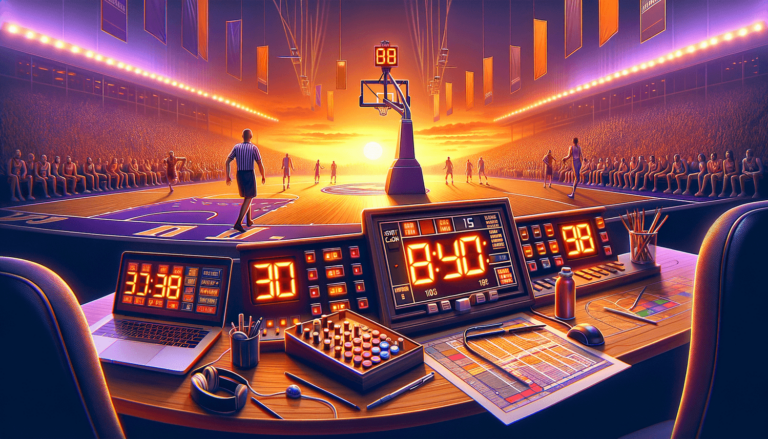
Understanding Shot Clock Operator Rule in Basketball
Written by: Basketball Universe
Last updated:

Get ready to dive into the thrill of the game as we explore the often overlooked but incredibly vital role of the Shot Clock Operator. Mastering the ins and outs of this rule can bring a deeper appreciation for the cadence of the game, and even give you an upper hand in the heat of the moment. In this blog post, we’ll journey through the Shot Clock Operator rules from the basics to the finer details, ensuring that by the time you reach the final whistle, you’ll be a Shot Clock aficionado. So gear up, as we unravel the secret world of Timing Control, and leave you craving even more court-side knowledge!
Understanding Shot Clock Operator Rule in Basketball
The Shot Clock Operator Rule refers to the responsibilities and functions of the person managing the shot clock during a basketball game. The shot clock is a countdown timer used to enforce the offense’s time limit to attempt a field goal. The operator’s role is to start, stop, and reset the clock based on specific on-court actions, adhering to established league regulations. Accurate shot clock operation ensures fair play and maintains the flow of the game, contributing to a competitive and enjoyable experience for players and fans alike.
Mastering the Basics of Shot Clock Operation
Before we delve into the intricate world of shot clock management, it’s crucial to first understand the fundamentals. Basketball games are finely tuned machines, and the shot clock plays a critical role in maintaining the rhythm and pace of the game. Having a firm grasp of the shot clock’s primary purpose enables a more comprehensive understanding of its impact across various basketball rules and strategies.
What is the Shot Clock?
In basketball, the shot clock is a timer that imposes a limit on the offensive team as they work to attempt a field goal. The duration of the timer varies between leagues, with professional and college basketball games commonly using a 24-second and 30-second timer, respectively. The shot clock is designed to keep games moving at a brisk pace while promoting a level playing field for both teams.
Why is a Shot Clock Operator needed?
While the shot clock is a crucial part of the game, its proper management requires the dedicated attention of a Shot Clock Operator. This individual has the crucial task of starting, stopping, and resetting the shot clock according to specific game events and NBA, FIBA, or NCAA regulations. Their precise and accurate operation ensures the smooth flow and fair playing standards vital to the excitement and enjoyment of basketball.
The Shot Clock Operator’s Role and Duties
Now that we’ve covered the basics, it’s time to dive into the significant responsibilities of the Shot Clock Operator. To make your shot clock mastery journey more enjoyable, we’ve divided this section into four main subsections: Starting the Clock, Stopping the Clock, Resetting the Clock, and Swapping Clocks.
Starting the Clock
The Shot Clock Operator initiates the clock when specific triggers are met, including:
- A team gains possession of the ball immediately following a jump ball, inbounding of the ball, or a made basket by the opposing team.
- Play resumes after a timeout, and a team gains possession of the ball.
- A player makes a legal touch of the ball after a rebound, steal, or loose ball recovery.
It’s essential to remember that the shot clock starts only when a player on the offensive team makes contact with the ball, ensuring that the allotted time is used effectively.
Stopping the Clock
Several game events call for the Shot Clock Operator to halt the timer, such as:
- A referee’s whistle signals a stoppage in play due to fouls, violations, or unexpected events (e.g., injury, equipment malfunction).
- A team scores a field goal, resulting in a change of possession.
- The shot clock reaches zero, and either the offense has released a field goal attempt or the defense gains possession of the ball.
- A timeout is called by one of the teams, or an official’s timeout is enforced.
Being vigilant and having a keen sense of timing is crucial for the Shot Clock Operator, as a quick response can have a significant impact on the flow of the game and the outcome of specific plays.
Resetting the Clock
The Shot Clock Operator must reset the clock when:
- Either team scores a field goal, resulting in possession change.
- A jump ball situation arises and the offense retains possession.
- An offensive foul is called, but the defense retains possession.
- Intentional fouls occur that award the offensive team an inbounding opportunity.
- A kick ball violation is called on the offense, and the subsequent inbounding does not reset the full 24/30 second shot clock (NBA-FIBA/NCAA).
- A successful shot attempt hits the rim, but the offense recovers the ball.
Adhering to these reset scenarios is crucial to maintaining the game’s momentum and ensuring fairness under various basketball rules and conditions.
Swapping Clocks
In some cases, Shot Clock Operators may need to transition to the game clock temporarily. Instances where this might happen include:
- The game clock malfunctions or becomes inoperable, leaving the shot clock as the primary timer.
- Confusion or misunderstanding regarding the events that would normally trigger the game clock.
Shot Clock Operators must be prepared and adaptable to manage the game clock and any other timing complexities that might arise.
Shot Clock Operator Communication and Coordination
An effective Shot Clock Operator must expertly manage the game’s pace while maintaining strong communication and coordination with game officials and fellow table crew members. This section explores two key elements of Shot Clock Operator communication: Liaison with Officials and Interacting with the Official Scorer.
Liaison with Officials
The Shot Clock Operator’s primary communication partners on the court are the referees. Officials rely on the Shot Clock Operator’s vigilance and quick responses to ensure accuracy and enforce basketball rules. Open communication channels with referees are vital for:
- Clarifying calls, violations, or discrepancies in the clock.
- Correcting any operator errors that may occur during the game.
- Maintaining mutual understanding on timing events and transitions in game phases.
Establishing a strong rapport with officials allows the Shot Clock Operator to perform their duties seamlessly, providing an engaging and enjoyable atmosphere for players and spectators alike.
Interacting with the Official Scorer
Another essential communication element for Shot Clock Operators is coordination with the Official Scorer. These table crew members work closely to ensure:
- Accurate accounting of the game’s statistics and events.
- Issuing timely and correct updates on team fouls, player fouls, and possession arrows.
- Maintaining open communication when discrepancies or unexpected events require teamwork and problem-solving.
Having an effective working relationship with the Official Scorer naturally boosts the Shot Clock Operator’s performance and the game’s overall quality.
Shot Clock Strategies and Gameplay Implications
With a profound understanding of Shot Clock Operator rules, it’s essential to examine the strategies that teams employ to maximize the shot clock and exploit opposing defenses. This section offers valuable insights into how the shot clock influences gameplay on a tactical level.
Shrinking the Clock: Deliberate Slowing of the Game
Some teams may try to limit the opponent’s opportunities on offense by deliberately running down the shot clock before attempting a field goal. This “shrinking the clock” strategy can be advantageous if the team has a lead or seeks to disrupt the opponent’s rhythm. However, engaging in this tactic too early or too often can prove risky, potentially leading to hurried, lower-percentage shots or shot clock violations.
Running a Two-for-One Play
A “two-for-one” play refers to the offensive team attempting to get off two possession attempts on their end of the floor while limiting their opponents to just one possession attempt. This strategy is often employed in the final minute of a quarter, as teams look to maximize scoring opportunities and reduce the gap or extend their lead.
Managing Situations with a Differential between Shot and Game Clocks
Occasionally, situations will arise where there’s not a significant difference between the shot clock and game clock, resulting in teams having to think tactically. For instance, during the final seconds of a quarter or game, teams strategize to maximize their last possession, weighing the benefits of launching a quick shot for a potential two-for-one opportunity or holding the ball till the last moment to deny the opponent any chance to score.
In Conclusion
As we’ve seen, the Shot Clock Operator’s rule is central to the excitement, rhythm, and fair play that makes basketball such an intriguing and captivating sport. From mastering the basic triggers and clock management duties to communicating with officials and grasping the game’s strategic implications, a deep understanding of shot clock operation presents unrivaled insight into the court’s intricacies. While this post provided a comprehensive overview, there’s always more to learn and appreciate within the world of basketball rules and strategies, ensuring that you’ll continue to find even greater enjoyment and passion for this fast-paced, high-flying sport.
Shot Clock Operator Qualifications and Training
For those intrigued by the Shot Clock Operator role and seeking to provide their expertise in managing this crucial game timer, it’s essential to understand the qualifications and training required to excel in this position.
Qualifications and Skills
Though specific requirements may vary across different leagues or levels of basketball, certain qualifications and skills tend to be valuable assets for any aspiring Shot Clock Operator:
- A deep understanding of basketball rules and the shot clock’s significance within the game.
- Strong communication and interpersonal skills to coordinate with fellow table crew members and game officials.
- Attentiveness and a keen sense of timing and numeracy to respond promptly to game situations.
- Adaptability and problem-solving capabilities to handle unexpected events, such as equipment malfunctions or rule discrepancies.
Training and Mentorship
Becoming a competent Shot Clock Operator often entails a combination of classroom training, hands-on experience, and mentorship. Key elements of this training process include:
- Participating in training sessions or workshops, learning from experienced operators and trainers about the essentials of shot clock management.
- Actively studying basketball rules and guidelines from governing bodies such as the NBA, FIBA, or NCAA to remain up-to-date on regulations and best practices.
- Observing experienced operators during games or scrimmages, taking notes, and inquiring about specific situations or techniques to refine one’s skills.
- Working alongside a mentor who can provide guidance, answer questions, and offer invaluable input to cultivate a deeper understanding of the role.
By diligently pursuing training, education, and mentorship opportunities, anyone with a passion for basketball can become a skilled and reliable Shot Clock Operator, contributing to the quality and enjoyment of the game for players, officials, and fans alike.
Common Shot Clock Operator Errors and How to Avoid Them
As with any role that demands precision and attentiveness, the Shot Clock Operator position inevitably comes with occasional errors. Recognizing these common mistakes and understanding how to avoid them can significantly improve a Shot Clock Operator’s performance and impact on the game.
Mistimed Clock Starts
One potential error operators may face is starting the clock either too early or too late. This mistake can be costly, as it disrupts the game’s flow and potentially impacts the outcome of plays. To avoid this error, Shot Clock Operators should pay close attention to when a player from the offensive team makes contact with the ball and only then start the clock. Watching both the game and the officials will also help to ensure proper clock management.
Incorrect Clock Resets
Another common mistake is resetting the clock when it should not be reset, potentially giving one team an unfair advantage. To prevent this error, operators must have a thorough understanding of the specific scenarios where a reset is necessary and maintain open communication with game officials for any clarification or correction needed.
Failure to Stop the Clock Timely
Failing to stop the clock when required can result in both lost time and confusion among players, officials, and fellow table crew members. Building a strong familiarity with game situations that call for a halt in the shot clock and anticipating these moments ahead of time will help ensure timely and accurate stoppages that keep the game on track.
By recognizing and addressing these common errors, Shot Clock Operators can elevate their skills, provide seamless game management, and contribute to an engaging and fair experience for all participants.
Frequently Asked Questions
Below is a curated list of frequently asked questions related to the Shot Clock Operator Rule in Basketball. These questions and answers provide additional insights and information to enhance your understanding of this essential aspect of the game.
1. Why is the shot clock duration different between the NBA and NCAA?
The difference in shot clock duration between the NBA (24 seconds) and NCAA (30 seconds) is primarily due to the NBA’s emphasis on fostering a faster-paced game with increased scoring opportunities, while the NCAA allows players more time to develop plays and execute strategies, given the amateur nature of college basketball.
2. What happens if the Shot Clock Operator makes a mistake?
If a Shot Clock Operator makes a mistake, the clock can be corrected in consultation with the game officials. In some cases, the referees may need to stop the game momentarily to resolve any timing discrepancies, ensuring that the game proceeds fairly and accurately.
3. Are there variations in Shot Clock Operator rules between leagues?
Yes, there can be variations in Shot Clock Operator rules between leagues such as the NBA, FIBA, and NCAA. Although the core responsibilities are generally consistent, specific rules, triggers, and regulations may differ between leagues, making it essential for operators to familiarize themselves with the relevant rulebook and guidelines for the league in which they are operating the shot clock.
4. Is it possible for a Shot Clock Operator to be penalized or sanctioned for a mistake?
While it is rare for a Shot Clock Operator to be penalized or sanctioned, recurring mistakes or failure to adhere to league standards can result in potential retraining, reassignments, or, in extreme cases, removal from their position. However, this usually only occurs when the mistakes affect multiple games or disrupt the fairness and overall experience of the sport.
5. If the shot clock resets after hitting the rim, does the game clock stop as well?
No, the game clock does not stop when the shot clock resets after hitting the rim, unless there is another event, such as a rebound going out-of-bounds or a foul being called, that requires the game clock to be stopped. In normal circumstances, the game clock continues to run as the shot clock resets.
6. How does a Shot Clock Operator know when to reset the shot clock to a shorter duration (14 seconds in the NBA and FIBA, and 20 seconds in the NCAA)?
The Shot Clock Operator resets the shot clock to the specified shorter duration in certain situations, such as when an offensive team retains possession of the ball after a kickball violation or an unsuccessful shot attempt hitting the rim. The Shot Clock Operator should closely follow the game action and understand league guidelines to make proper timing decisions in such scenarios.
7. What measures are in place to prevent Shot Clock Operator errors?
Shot Clock Operators undergo comprehensive training, education, and mentorship programs to minimize errors. Additionally, effective communication with officials, coordination with fellow table crew members, and building strong familiarity with game situations and league rules all contribute to reducing Shot Clock Operator errors and ensuring the accuracy and fairness of the game.
8. Are Shot Clock Operators required to memorize all possible clock scenarios?
While not required to memorize every possible scenario, Shot Clock Operators should have a strong familiarity with and understanding of common game situations that would affect the clock. Continuous learning and study of basketball rules and gaining experience operating the clock will help Shot Clock Operators effectively handle various game scenarios.
9. Are there any technological advancements being considered to assist Shot Clock Operators?
Yes, various technological advancements have been considered to assist Shot Clock Operators, such as automated game clocks and scoreboards or advanced systems that can detect change-of-possession or shot attempts. However, successfully integrating these technologies while maintaining fairness and accuracy in the game remains a challenge, and the Shot Clock Operator’s expertise continues to be an indispensable resource on the court.
10. Can a team’s coach challenge a Shot Clock Operator’s decision?
Though coaches may express concerns regarding the shot clock’s timing, only game officials have the authority to consult and collaborate with the Shot Clock Operator to correct any potential errors. As a result, coaches can communicate their concerns to game referees, who will then determine whether any adjustments to the shot clock are necessary, ensuring a fair and accurate game environment.
Featured Posts
- No pillar pages found.





